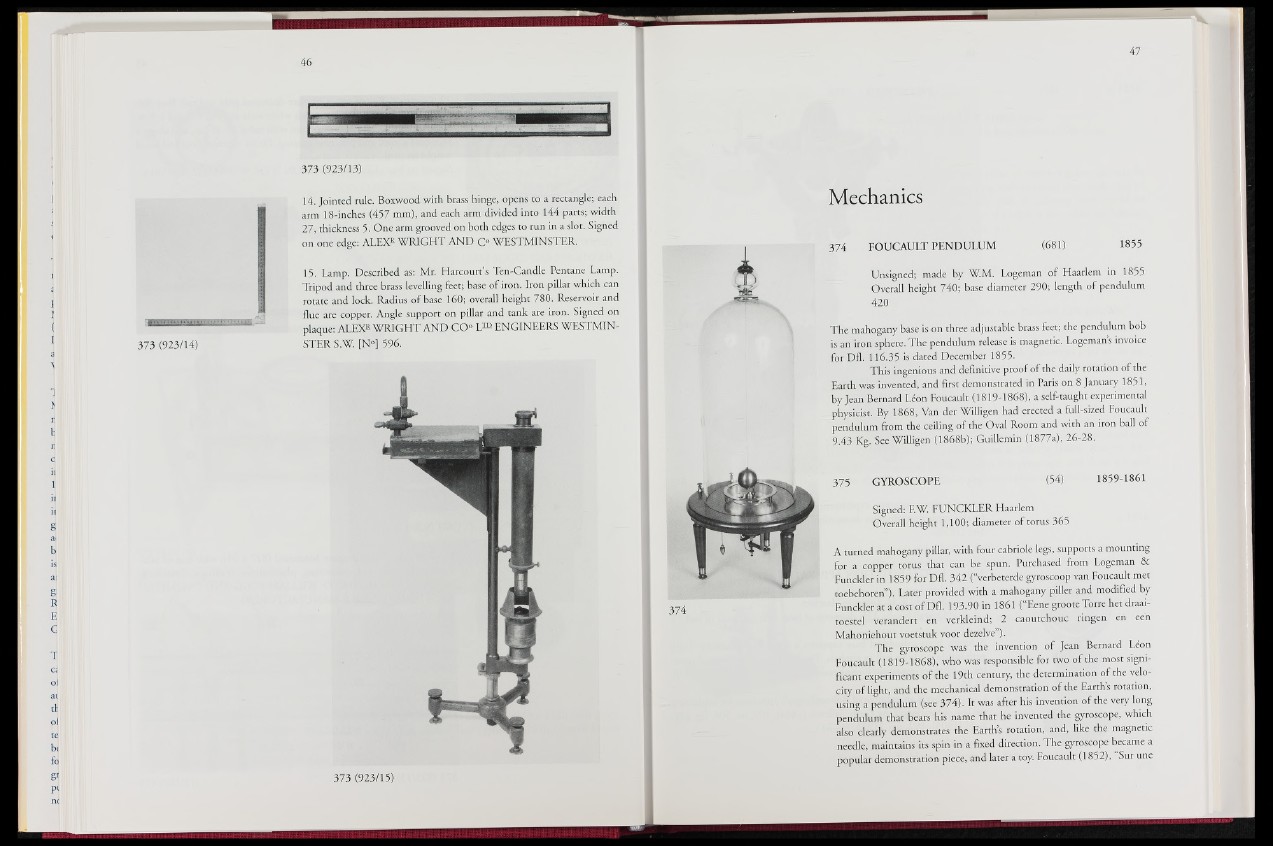
373 (923/13) :
14. Jointed rule. Boxwood with brass hinge, opens to a rectangle; each
arm 18-inches (457 mm), and each arm divided into 144 parts; width
27, thickness 5. One arm grooved on both edges to run in a slot. Signed
on one edge: ALEX£ WRIGHT AND C° WESTMINSTER.
15. Lamp. Described as: Mr. Harcourt's Ten-Candle Pentane Lamp.
Tripod and three brass levelling feet; base of iron. Iron pillar which can
rotate and lock. Radius of base 160; overall height 780. Reservoir and
flue are copper. Angle support on pillar and tank are iron. Signed on
plaque: AT EXE WRIGHT AND CO° Lm ENGINEERS WESTMINSTER
S.W. [N°] 596.
373 (923/15)
Mechanics
374 FOUCAULT PENDULUM (681) 1855
Unsigned; made by W.M. Logeman of Haarlem in 1855
Overall height 740; base diameter 290; length of pendulum
420
The mahogany base is on three adjustable brass feet; the pendulum bob
is an iron sphere. The pendulum release is magnetic. Logemans invoice
for Dfl. 116.35 is dated December 1855.
This ingenious and definitive proof of the daily rotation of the
Earth was invented, and first demonstrated in Paris on 8 January 1851,
by Jean Bernard Léon Foucault (1819-1868), a self-taught experimental
physicist. By 1868, Van der Willigen had erected a full-sized Foucault
pendulum iffpm the ceiling of the Oval Room and with an iron ball of
9.43 Kg. See Willigen (1868b); Guillemin (1877a), 26-28.
375 GYROSCOPE (5 4 )» 1859-1861
Signed: F.W. FUNCKLER Haarlem
Overall height 1,100; diameter of torus 365
A turned mahogany pillar, with four cabriole legs, supports a mounting
for a copper torus that can be spun. Purchased from Logeman &
Funckler in 1859 for Dfl. 342 (“verbeterde gyroscoop van Foucault met
toebehoren”). Later provided with a mahogany piller and modified by
Funckler at à cost of Dfl. 193.90 in 1861 ( Eene grooteTorre het draai-
töestel verändert en verkleind; 2 caoutchouc ringen en een
Mahoniehout voetstuk voor dezelve”).
The gyroscope was the invention of Jean Bernard Léon
Foucault (1819-1868), who was responsible for two of the most signi-
' ficant experiments of the 19th century, the determination of the velocity
of light, and the mechanical demonstration of the Earths rotation,
using a pendulum (see 374). It was after his invention of the very long
pendulum that bears his name that he invented the gyroscope, which
also clearly demonstrates the Earth’s rotation, and, like the magnetic
needle, maintains its spin in a fixed direction. The gyroscope became a
popular demonstration piece, and later a toy. Foucault (1852), Sur une